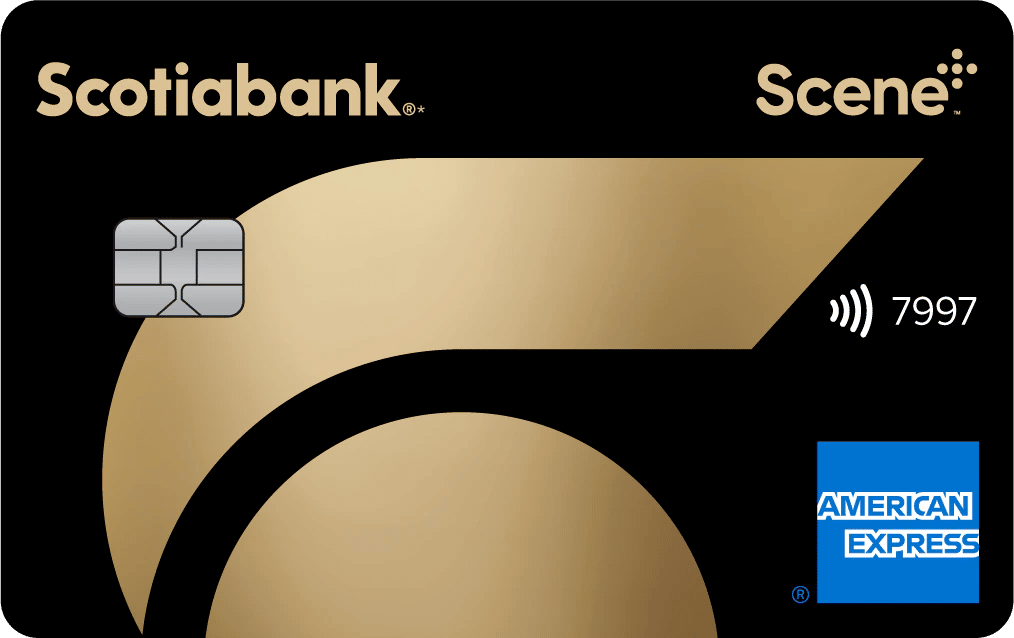In this edition of Head-to-Head, we’ll take a look at two credit cards in the Canadian marketplace that are known for their very strong earning rates: the American Express Cobalt Card and the Scotiabank Gold American Express Card.
While these cards are overall quite similar, there are several notable differences that may sway your decision either way, or might even compel you to give both of them a place in your wallet. Let’s compare the two cards in all the ways that matter.
Card Basics
When deciding between two credit cards, the most important comparisons will always be made on a few key factors.
1. Welcome Bonuses
The Amex Cobalt Card currently offers up to 15,000 Membership Rewards (MR) points over the course of the first year of card membership, structured as follows:
- 1,250 MR points upon spending $750 (all figures in CAD) in each of the first 12 months
On the other hand, the Scotiabank Gold American Express Card currently offers up to 40,000 Scene+ points,† available until July 1, 2024, distributed as follows:
- 20,000 Scene+ points upon spending $1,000 in the first three months†
- 20,000 Scene+ points upon spending $7,500 in the first year†
Verdict: As you can see, both cards’ current welcome bonuses are structured quite differently.
The Cobalt Card requires a higher total spend of $9,000 over the first year to unlock the full bonus, and you’ll have to keep track of the monthly spending requirement to boot.
The current offer on the Scotiabank Gold American Express Card has a more traditional structure, with half of the welcome bonus awarded upon spending $1,000 in the first three months, and then the other swath upon spending a total of $7,500 in the first year.
Putting aside the differences between Membership Rewards points and Scene+ points for now (which we’ll address later), the edge shifts in the Scotiabank Gold American Express Card’s favour due to a lower total minimum spending requirement and a higher total welcome bonus.
2. Referral Bonuses
Like other American Express products, the American Express Cobalt Card offers a referral bonus of 5,000 MR points for each friend or family member you refer to a card of their own, up to a maximum of 75,000 MR points in a calendar year.
Scotiabank credit cards do not offer referral bonuses, so Scotiabank Gold Amex cardholders would miss out on this method of supercharging their points balances.
Verdict: Only the Amex Cobalt Card has a referral bonus of any kind, so it wins this round handily.

3. Annual Fee
The Cobalt Card operates on a monthly fee model. The $12.99 monthly fee is charged on every statement, and adds up to $155.88 over the course of a year.
Meanwhile, the Scotiabank Gold Amex has a $120 annual fee, which is charged entirely upfront.
Verdict: Even though the Cobalt’s monthly fee structure works in its favour in that you can pay less fees upfront, its overall price point is still higher. The Scotiabank Gold American Express Card wins this round.
4. Earning Rates
This is arguably the most significant comparison for us to look at, since the elevated earning rates on select spending categories is what lies at the heart of both of these cards’ identities.
Spending on the Amex Cobalt Card will earn you the following:
-
5 MR points per dollar spent on groceries, dining, and food delivery
- 3 MR points per dollar spent on streaming services
-
2 MR points per dollar spent on travel, transit, and gas
-
1 MR point per dollar spent on all other purchases

Meanwhile, the Scotiabank Gold American Express Card has the following earning rates:
-
6 Scene+ points per dollar spent on Sobeys, IGA, Safeway, FreshCo, and more
-
5 Scene+ points per dollar spent on groceries, dining, and entertainment
-
3 Scene+ points per dollar spent on gas, transit, and streaming services
-
1 Scene+ point per dollar spent on all other purchases

If we once again put aside the differences in inherent value between Membership Rewards and Scene+ points for now, and look solely at the earning rates, we see that the two cards match each other at 5x for groceries and dining and at 3x for streaming.
Other than that, the Scotiabank Gold American Express Card wins out for purchases at Empire grocery stores (6x vs. 5x), in the entertainment category (5x vs. 1x) and the transit and gas categories (3x vs. 2x), while the Cobalt wins out in the travel category (2x vs. 1x).
Verdict: Looking at earning rates alone, the two cards are fairly even in key categories; however, the Scotiabank Gold American Express Card continues to hold the edge in more categories than the Cobalt.
If you’re someone who wants to use these cards primarily as a vehicle towards fixed-value redemptions on your travel purchases, perhaps for booking independent hotels or cruises, you’d do better with the Scotiabank Gold Amex than the Cobalt.
5. Cap on Higher Earning Rates
This is a minor point for the majority of credit card users, but will be of particular concern to anyone who transacts at high volumes.
The Scotiabank Gold American Express Card limits cardholders to accelerated earning rates on the first $50,000 of purchases in the 6x, 5x, and 3x categories every calendar year.
Meanwhile the Cobalt imposes a stricter limit of $2,500 per month on the 5x category, or $30,000 for the card membership year.
Verdict: The Scotiabank Gold American Express Card’s higher transaction limits means that anyone with significant spending requirements can extract more out of the bonus categories on a yearly basis than via the Amex Cobalt.
6. Foreign Exchange Rate
Finally, the Amex Cobalt charges a 2.5% foreign transaction fee on any purchases in a foreign currency, while the Scotiabank Gold American Express Card doesn’t levy foreign transaction fees.
Verdict: The Scotiabank Gold American Express Card is the clear winner with a 0% foreign transaction fee. Plus, Scotiabank remains the only large bank in Canada to offer products with no foreign transaction fees.
Points Currencies
The value proposition of these two credit cards is also closely tied to the redemption possibilities of the points currencies they respectively earn: Amex Membership Rewards points and Scene+ points. Thus, we must pit these against each other as well.
1. Redemption Methods
The Amex Cobalt Card earns the powerful Membership Rewards points that can be transferred to airline partners like Aeroplan, British Airways Executive Club, Air France KLM Flying Blue, Marriott Bonvoy, and more. Combined with the card’s 5x earning rate, this makes the Cobalt one of the most powerful credit cards in Canada, if not the most powerful card.
Aeroplan points, Avios, Flying Blue miles, and other airline transfer partners are best redeemed for high-value flights in premium cabins. While the actual redemption value varies significantly, you can expect to get anywhere from 2–10+ cents per point, depending on how you redeem your points.
If you aren’t able to locate award availability, the Amex Fixed Points Travel Program can be a very useful backup option, capping out at a redemption value of 2 cents per point.
On the other hand, Scene+ points can be redeemed to offset against the cost of travel charged to the credit card at a baseline rate of 1 cent per point – a feature that’s also shared by Amex MR points.
Verdict: Both Amex MR and Scene+ points can be cashed out against travel purchases at 1 cent per point, but MR points can be redeemed for much higher value through airline or hotel transfers, so it’s the clear winner here.

2. Ease of Redeeming
There’s also something to be said for how easy it is to redeem your points in any program, and the good news is that both Membership Rewards and Scene+ allow you to make redemptions pretty effortlessly.
Notably, Scene+ allows you to retroactively use points to offset any travel purchase you make on the card, instead of forcing you to book on points through the bank’s in-house travel agency. This is a much more favourable scheme than many of its competitors among Canada’s Big 5 banks.
Likewise, you can redeem Amex MR points at a fixed value of 1 cent per point against almost any charge made on your card.
Verdict: Honours even.
Other Factors
Finally, we’ll look at the cards’ ancillary benefits and any other last-ditch considerations that might sway your choice in either of their favour.
1. Travel Insurance
Insurance can be a major factor in choosing a credit card, and the Amex Cobalt and Scotiabank Gold Amex Card each have their strengths and weaknesses:
-
The Cobalt offers up to $5,000,000 in emergency medical insurance for the first 15 days of your trip, while the Scotiabank Gold Amex offers up to $1,000,000 for the first 25 days of your trip (3 days aged 65 and up).
-
The Cobalt does not offer Trip Cancellation/Interruption insurance, while the Scotiabank Gold Amex offers coverage of up to $1,500 per person, with a maximum of $10,000 per trip.
-
Baggage delay insurance is provided by the Cobalt for up to $500 on delays of six hours or more, and on the Scotiabank Gold Amex for up to $1,000 per group, for delays of four hours or more.
-
The Cobalt’s car rental collision and damage waiver applies on automobiles with an MSRP of up to $85,000, while the Scotiabank Gold Amex’s equivalent provision is limited to an MSRP of $65,000.
Depending on how you travel and your age, you may benefit more from the Scotiabank Gold American Express Card’s emergency medical insurance coverage, which is less comprehensive in terms of the dollar amount but covers a longer out-of-province trip.
Also note that as with all forms of credit card insurance, the emergency medical insurance applies to you whether or not you booked the trip using the card, while all the other insurance items only apply if you charge the cost of the trip to the card.
In particular, the Amex Cobalt’s insurance perks would apply if you were redeeming MR points (for example via the Fixed Points Travel program), but not if you redeemed any other type of points.
Verdict: These two cards each have their own strengths when it comes to travel insurance propositions, but the Scotiabank Gold American Express Card wins thanks to its longer emergency medical coverage, stronger Trip Cancellation/Interruption provisions, shorter duration for baggage delay, and more.
2. Ease of Getting Approved
To be eligible for the Scotiabank Gold American Express Card, you’ll need a minimum personal annual income of $12,000 to apply, whereas American Express just doesn’t do minimum income requirements.
Furthermore, Scotiabank requires a minimum credit limit of $5,000 for this card, so your eligibility will depend on whether your credit score is good enough for Scotiabank to be comfortable extending you that much credit, whereas American Express has no such specifications.
Verdict: Based on the above thresholds as well as anecdotal evidence, American Express’s general leniency across the board in approving new credit applications makes it the winner in this category, which gives the edge to the Amex Cobalt Card.
However, it’s worth noting that the minimum income requirement on the Scotiabank Gold Amex Card is also quite favourable, especially for a travel card with so many benefits.
3. Supplementary Cards
The Cobalt Card is one of the few Amex cards to make supplementary cards available for free, whereas the Scotiabank Gold American Express Card will bill you $29 per year for every additional cardholder you add.
Verdict: The Cobalt Card is much more friendly to supplementary cards, which can work out well to help pad your balance each month.
4. Amex Offers
Since they’re both on the American Express network, both the Amex Cobalt and the Scotiabank Gold Amex are eligible for lucrative Amex Offers.
On the Cobalt Card, eligible offers are typically added automatically to your online account.
On the other hand, the Scotiabank-issued Amex cards require you to register manually for Amex Offers via a dedicated registration page, and not all Amex Offers may be available for registration.

Verdict: While both cards enjoy the savings and bonuses available through Amex Offers, Cobalt cardholders will usually receive a wider range of offers on their accounts, without having to register manually through a separate page.
5. Visual Appearance
The Cobalt has had one of the most striking designs in the credit card marketplace ever since it was introduced. It features the famous Centurion in the centre, with on-brand cobalt blue and a textured background, all on a card made from recycled plastic.
Meanwhile, the Scotiabank Gold American Express Card features on-brand black and gold tones, with Scotiabank’s logo stylized in the background.

Verdict: The Cobalt Card’s visual appearance is in a league of its own, with the instantly recognizable Centurion and a striking design.
Conclusion
The American Express Cobalt Card and the Scotiabank Gold American Express Card are both excellent credit cards, thanks to their strong earning rates and many features, and there are several compelling reasons why you might go for either card over the other.
The Cobalt Card would be a better choice for those of you seeking high-value travel redemptions, as its Membership Rewards points are more powerful than the Scene+ points offered by its competitor here.
However, the strong earning rates on the Scotiabank Gold American Express Card (especially 6x at Empire grocery stores) also make it a worthy option, especially with its higher limit of $50,000 in annual purchases at the elevated rates compared to the Cobalt Card’s $2,500 monthly limit on 5x purchases.
Depending on how you redeem points, you may even come out ahead with the Scotiabank Gold Amex, thanks to higher earning rates in more categories.
In any event, if you have consistently high spending in the 5x categories, you’re very likely to benefit from alternating between both cards to enjoy the best of both worlds.





















